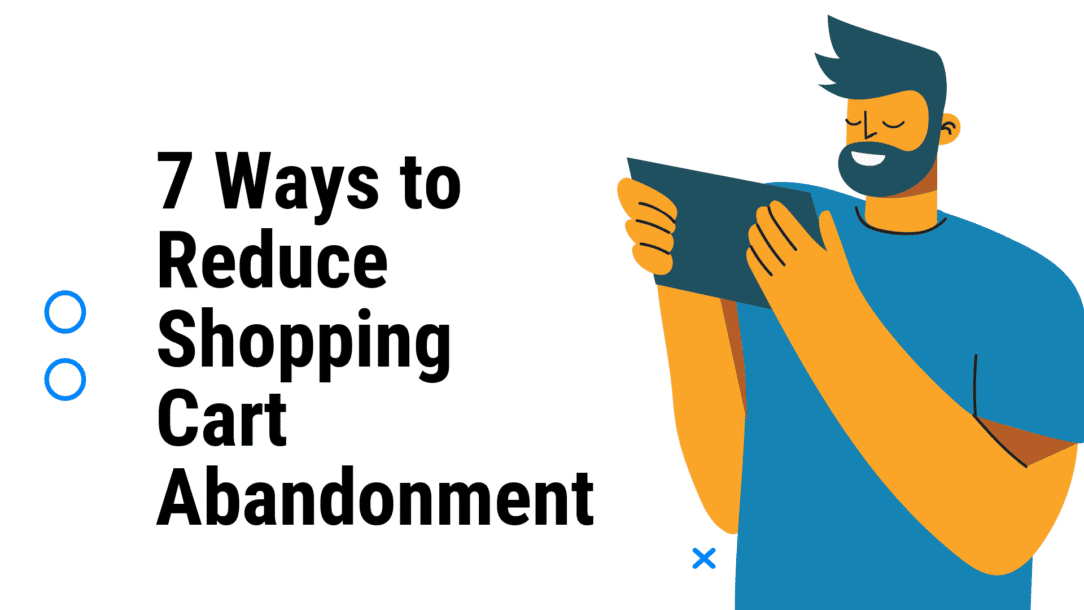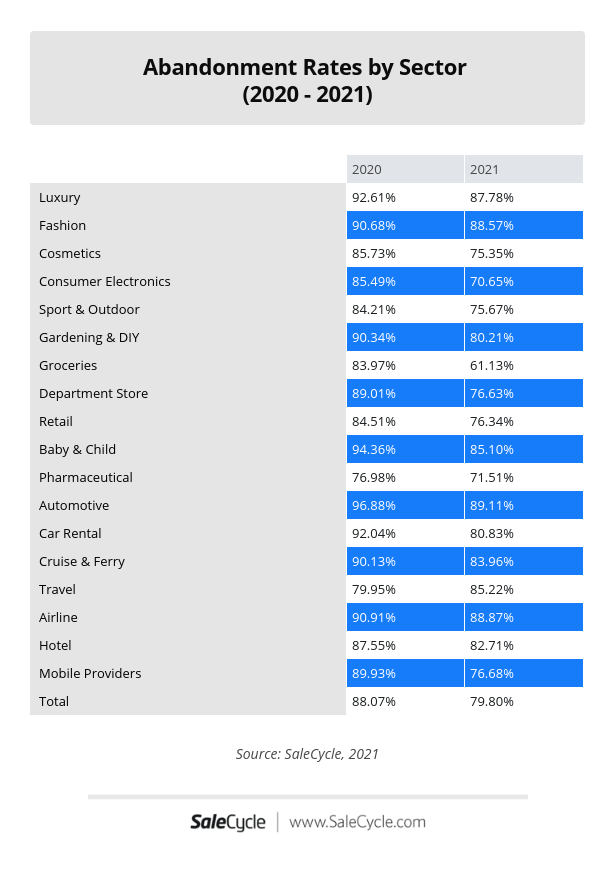Imagine this! You have finally completed setting up your eCommerce store. You’ve chosen the perfect platform, designed eye-catching product pages, and written compelling descriptions. You’re ready to launch and start making sales… but there’s just one problem. No matter how great your store is, how awesome your products are, or how low your prices are… you’re still losing a significant portion of your potential customers to shopping cart abandonment. Why do customers abandon their shopping carts? Why is this happening, and more importantly, what can you do to reduce shopping cart abandonment in your eCommerce store?
In this article, we’ll discuss:
- The definition of shopping cart abandonment
- The most common reasons for shopping cart abandonment
- How to calculate your shopping cart abandonment rate
- 7 ways to reduce shopping cart abandonment (with brand examples)
By the end of this article, you’ll better understand what shopping cart abandonment is, why it’s happening in your store, and what you can do to fix it. So let’s jump right in!
What is Shopping Cart Abandonment?
Shopping cart abandonment is when a customer adds items to their online shopping cart but doesn’t complete the purchase. In other words, they abandon their shopping cart. For example, let’s say a customer visits your eCommerce store and adds a pair of shoes to their shopping cart. But instead of proceeding to checkout, they leave your site without purchasing the shoes. This is an example of shopping cart abandonment. Shopping cart abandonment is a huge problem for eCommerce store owners. In fact, the average shopping cart abandonment rate is a whopping 73%, as this much audience is leaving without completing a purchase.
And if you think that shopping cart abandonment only happens to small businesses, think again! Even big businesses like Amazon have a shopping cart abandonment rate high; seven out of every ten customers leave without completing a purchase.
Now that we’ve answered the question “what is shopping cart abandonment?”, let’s take a look at the most common reasons for shopping cart abandonment.
The Most Common Reasons for Shopping Cart Abandonment
There are many different reasons why customers may abandon their shopping carts. Some customers may not be ready to purchase yet, while others may have had a negative experience with your store. Some customers may simply change their minds, while others may have found a better deal elsewhere.
Let’s take a look at the most common reasons for shopping cart abandonment:
1. Customers are Just Hanging Out:
This is the very first reason for shopping cart abandonment and the most difficult to spot. Just because customers have added items to their shopping cart doesn’t mean they’re ready to purchase. In fact, many customers use the shopping cart as a “wish list” feature, adding items they’re interested in but not necessarily ready to buy. These customers are just browsing your store and may or may not come back to purchase the items in their cart. There’s not much you can do about this other than continue marketing to them and hope they come back when they’re ready to buy.
2. Hidden or High Shipments Costs:
Customers are often surprised by high shipping costs when they get to the checkout page. In fact, 49% of customers say they would abandon their shopping cart if the shipping costs were too high. When high shipping costs blindside customers, it leaves a bad taste in their mouth, and they’re less likely to come back and purchase from your store again.
3. Lack of Payment Options:
Lack of payment options is another common reason for shopping cart abandonment. When customers are ready to purchase but can’t find a payment option that works for them, they’re likely to abandon their shopping cart.
4. Complicated or Lengthy Checkout Process:
A complicated or lengthy checkout process is another common reason for shopping cart abandonment. In today’s fast-paced world, customers don’t have the patience to fill out long forms or jump through hoops to complete a purchase.
5. Poor Website Design or User Experience:
Website design is very crucial for an eCommerce store. If a website is poorly designed or has a poor user experience, customers are likely to abandon their shopping carts and never come back.
6. Items Went Out of Stock:
Items going out of stock are yet another common reason for shopping cart abandonment. This is especially common during sales or holidays when demand is high, and inventory is low.
7. Asking Customers to Sign Up with Email:
Asking customers to sign up for an email list is common, but it can also lead to shopping cart abandonment. If customers aren’t ready to sign up for an email list, they may abandon their shopping cart rather than provide their email address.
8. No Proof or Testimonials:
Customers want to know that they can trust your store before they make a purchase. If there’s no proof or testimonials on your website, customers may be hesitant to make a purchase and may abandon their shopping cart as a result.
9. Slow Loading Pages:
Slow loading pages are a common problem for eCommerce stores. If customers have to wait too long for a page to load, they’re likely to get frustrated and abandon their shopping cart.
10. Password Issues:
If a customer has forgotten their password or is having trouble logging in, they may abandon their shopping cart rather than go through the hassle of resetting their password.
11. Too Many Forms:
If a customer is required to fill out too many forms, they’re likely to abandon their shopping cart. This is especially true if the forms are long and complicated.
12. Lack of Customer Support:
If customers can’t get help when they need it, they’re likely to abandon their shopping cart. When customers are struggling to complete a purchase or have questions about a product, they want to know that they can reach out to customer support for help.
13. The Checkout Page is Not Secure:
Customers want to know that their personal and financial information is safe when they make a purchase. If the checkout page is not secure, customers are likely to abandon their shopping cart. Out of all these reasons, the complicated checkout process is probably the most common and also the most important to fix. If your store has a complicated checkout process, customers are likely to abandon their shopping carts. In fact, studies by Bymard Institute found that the average shopping cart abandonment rate is as high as 41%.
Check the stats below from Bymard Institute:
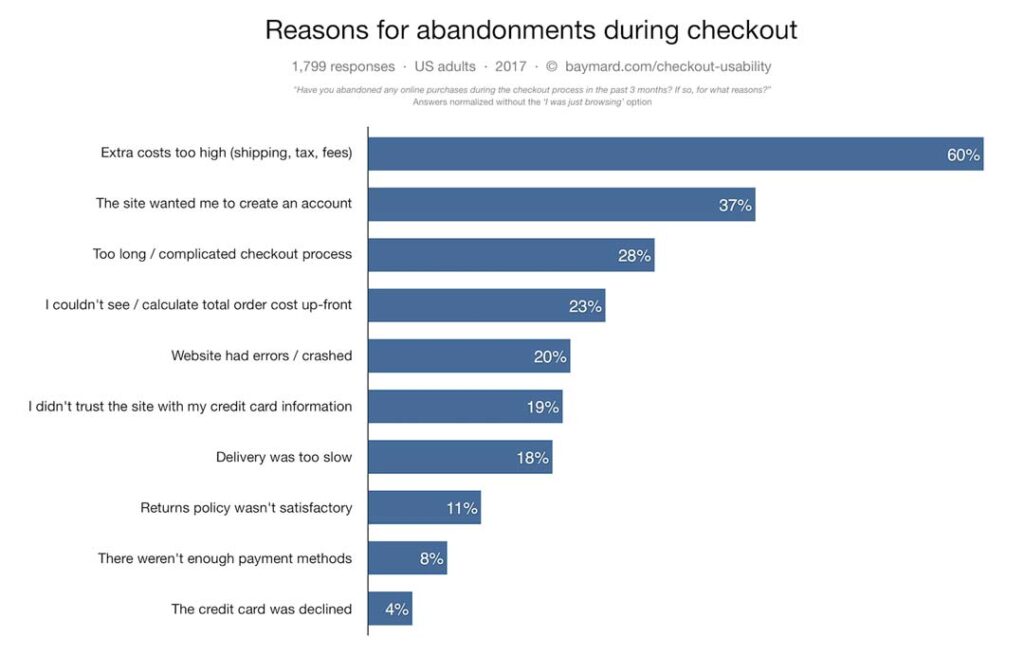
Bymard Institute
So, as you can see, a complicated checkout process is one of the main reasons for shopping cart abandonment. If you want to reduce shopping cart abandonment, you need to make sure that your checkout process is as simple and easy as possible. But why is cart abandonment such a big problem? Why should businesses care?
Why Cart Abandonment is the Main Issue with e-commerce Retailers?
There are many reasons why cart abandonment is such a big issue for e-commerce retailers. First, it’s important to understand that the average order value for an eCommerce store is $80. So, if a customer abandons their shopping cart with an average order value of $80, the store is losing out on a lot of potential revenue. And according to statistics, 70% of customers who abandon their shopping carts never return. So, if we do the math, for every ten abandoned shopping carts, the store is losing out on seven potential customers.
Not only that, but it’s also important to understand that it costs 5 times more to acquire a new customer than it does to retain an existing one. So, if a store is losing out on potential customers, they’re also losing out on potential revenue. And lastly, it’s important to understand that the average shopping cart abandonment rate is as high as 41%, as we talked about it earlier. So, if a store has a shopping cart abandonment rate of 41%, it means that they’re losing out on 41% of potential revenue.
Cart abandonment directly impacts the customer’s lifetime value and the store’s overall profitability. And that’s why it’s such a big issue for eCommerce retailers. In fact, if we take aside the financial revenue of the businesses, many issues can arise due to cart abandonment. A customer might need that product urgently but was unable to find it as the website had some sort of technical problem which led the customer to abandon their cart.
In this case, the customer might never return to that store again as they would’ve lost their trust. In some cases, the customer might’ve found a better deal on some other website and decided to buy it from there. The latter means that the store lost out on revenue and a potential customer. Or, if a customer leaves the store because of poor website design, it means that the store needs to work on its marketing strategy as well as on its website design and user experience.
After all the reasons, how would you know what the cart abadonement rate for your store is, and where you stand?
How to Calculate Your Shopping Cart Abandonment Rate?
The first step is to understand what your cart abandonment rate is. To do that, you need to take the number of abandoned shopping carts and divide it by the total number of shopping carts that were created. For example, if you had 100 shopping carts that were created and 10 of them were abandoned, your cart abandonment rate would be 10%. To get more accurate results, you need to track your abandoned shopping carts over a period of time. This will help you understand if there’s been an increase or decrease in the number of abandoned shopping carts.
You can use this formula to calculate your cart abandonment rate:
Number of Abandoned Shopping Carts/Total Number of Shopping Carts Created x 100 = Cart Abandonment Rate
It’s also important to segment your shopping cart data so that you can identify which products are being abandoned the most. This will help you understand why customers are abandoning their shopping carts and what you can do to reduce them. For example, if you see that a particular product is being abandoned more than others, it might be because of the product’s price or because of the shipping charges. In this case, you can either work on your pricing strategy or your shipping charges so that you can reduce the number of abandoned shopping carts.
What is an Average Shopping Cart Abandonment Rate by Industry?
The average shopping cart abandonment rate varies by industry. For example, the average abandonment rate for the retail industry is around 70%. This means that out of every 100 shopping carts that are created, 70 of them are abandoned. The average abandonment rate for the travel industry is around 89%. This means that out of every 100 shopping carts that are created, 89 of them are abandoned. Studies found that 45% of generation Z has the highest shopping cart abandonment rate as they visit multiple websites before making a purchase.
Check these stats from SaleCycle to see the cart abandonment rate by industry and device:
10 Ways to Reduce Shopping Cart Abandonment with Examples from Major Brands:
1. Provide Free Shipping and Free Return Offer
We talked about it before, but it’s worth mentioning again. Shipping charges are one of the major reasons why customers abandon their shopping carts. As a retail brand, you need to find ways to either reduce your shipping charges or provide free shipping. This will encourage customers to complete their purchases and not abandon their shopping carts. Free shipping is one of the best ways to reduce shopping cart abandonment. And it’s not just us saying it; even studies have shown that free shipping is one of the most important factors influencing a customer’s purchase decision.
Free shipping creates a psychological effect on customers where they feel like they’re getting a good deal and are more likely to complete their purchase. It’s human nature to want something for free. By providing free shipping, you’re satisfying this psychological need and increasing the chances of a sale. In addition to free shipping, you should also offer free returns. This will give customers the peace of mind that they can return the product if they’re not happy with it.
But the question is, how can you offer free shipping and free returns and still make a profit? The answer is simple. If the cost of shipping and returns is eating into your profits, you can keep this special offer for the customers who left their cart abandoned and send them an email about it. This is a great way to win back these customers and convert them into sales. And it’s not just us saying it; even major brands like Reformation offer free shipping and free returns. When you visit their site, the first option you see is their free shipping and free returns offer.
Check their homepage screenshot:

Do you see that? Now Reformation is a high-end fashion brand, and its prices are on the higher side. But even they offer free shipping and returns to encourage customers to complete their purchase. It’s not about free delivery within the US; Reformation offers free delivery worldwide. That’s the reason why Reformation has a loyal customer base who loves their brand and purchases from them frequently.
Check another example of Better World Book. They’re an online retailer that sells new and used books:
When you visit their site, the very first thing you see is their free shipping offer with 20% off if you purchase three used books.

Now think about it, what’s the likelihood of a customer abandoning their shopping cart when they see such an amazing offer?
It’s very low, right?
This is because the offer is too good to resist, and the customer is more likely to complete their purchase.
2. Allow Guest Checkout
Forcing customers to create an account before making a purchase is one of the major reasons why shopping carts are abandoned. Asking customers to create an account means they have to provide their personal information like name, address, email, etc. And most customers are not comfortable doing that, especially when they’re just making a one-time purchase. Think about it? A customer visits your site and finally finds the product they need, but after adding the product to their cart, they’re asked to create an account and add their personal information.
In such a case, it’s very likely that the customer will abandon their shopping cart and look for the same product on another site that offers guest checkout. It’s important to understand that not all customers want to create an account. In that case, allowing guest checkout is the best option. By allowing guest checkout, you’re giving customers the freedom to choose whether they want to create an account or not. And this increases the chances of a sale as the customer is not forced to do something they’re not comfortable with.
But since customers’ emails help you create targeted marketing campaigns, you can ask for the customer’s email address for future coupons, offers, and deals. This way, you can still get the customer’s email address but without forcing them to create an account. Check how big brands like Nike allow guest checkout. When customers see that they can checkout as a guest, they’re more likely to complete their purchase.
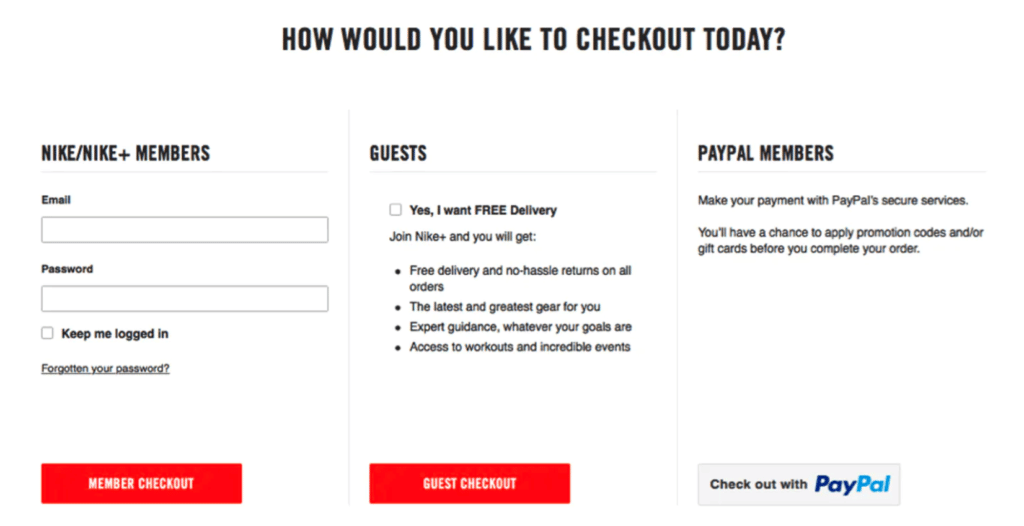
Nike’s Checkout Options
3. Collect Cart Abandonment Feedback with Chatbots
Did I tell you chatbots are leading the eCommerce revolution? If you’re not using chatbots on your eCommerce store, you’re missing out on a lot of valuable insights. Sometimes you don’t understand why customers are abandoning their shopping carts. In such cases, you need to communicate with the customer directly and find out its reason. But what if the customer is no longer active on your site? Or if there is more than one customer abandoning their shopping cart at the same time? It’s not possible for you or your customer support team to communicate with each and every customer. What helps here is automation!
You can use chatbots to collect feedback from customers who have abandoned their shopping carts. With the help of a chatbot, you can create a survey that appears as soon as the customer abandons their shopping cart. The survey will help you understand why customers are abandoning their shopping carts and what you can do to prevent it. Not only chatbots can help you collect feedback from customers, but they can also be used to engage with the customer and help them complete their purchases. How? By sending timely notifications and reminders to customers who have abandoned their shopping carts. You can also use chatbots to offer discounts and deals to customers in real-time.
With the help of a chatbot, you can quickly engage with the customer and address their concerns which increases the chances of a sale.
4. Simplify Checkout Process
A long and complicated checkout process is one of the main reasons for shopping cart abandonment. Customers want a quick and easy checkout process. If the checkout process is too long or complicated, customers are likely to abandon their shopping carts. You need to make sure that the checkout process on your eCommerce store is short and simple. The fewer steps in the checkout process, the better it is for your business. Think about it from the customer’s perspective. Would you want to go through a long and complicated checkout process? I’m sure your answer is NO.
The same applies to your customers. They want a quick and easy checkout process. To simplify the checkout process, you need to remove all the unnecessary steps.
For example:
- If you’re not offering to ship to certain countries, you can remove those countries from the list.
- If you have that information saved in your system, you can also pre-fill the customer’s information like shipping address and billing address.
You can do A/B testing to find out which checkout process works best for your business. A case study was done years ago but still, relevant today showed that reducing the number of form fields could get significant results.
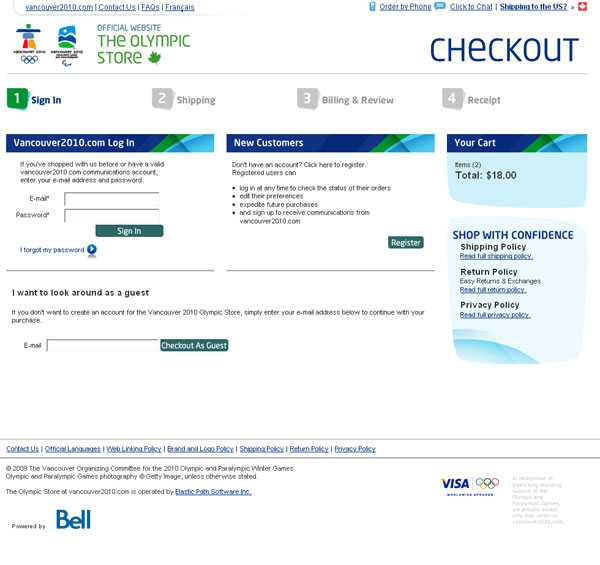
By reducing the number of form fields, you can simplify the checkout process and increase conversion rates.
5. Send Email Reminders
Cart abandonment happens all the time. But that doesn’t mean you can’t do anything about it. You can send email reminders to customers who have abandoned their shopping carts. Email reminders are a great way to bring customers back to your store and complete their purchases. With the help of email reminders, you can increase sales and reduce shopping cart abandonment. Usually, brands have a set time frame for sending email reminders. For example, they send the first email reminder after 24 hours, the second email reminder after 48 hours, and so on. But the best time to send an email reminder depends on your business. You need to experiment and find out what works best for you.
You can also personalize the email reminder based on the customer’s purchase history. For example, suppose a customer has abandoned a cart that had products from your summer collection. In that case, you can send them an email reminder about the new arrivals in your summer collection. You can also offer discounts, coupons, and deals in the email reminder to encourage customers to complete their purchases. This way, cross-selling and upselling become easier.
For instance, check this email reminder from Savyour:
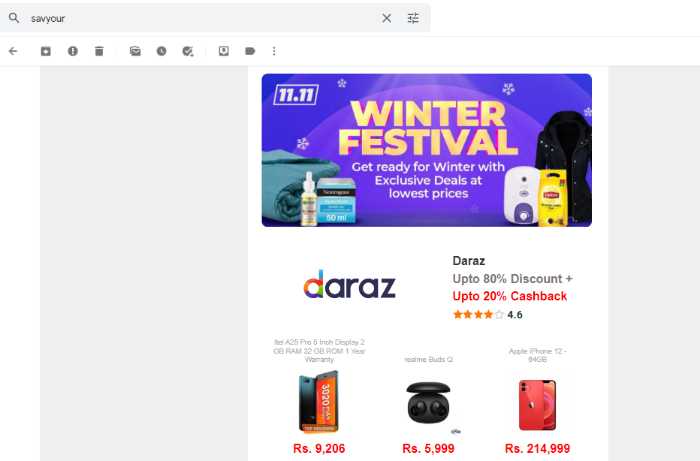
After spinning the wheel to get some discounts, I didn’t claim my prize and abandoned my shopping cart. Within minutes, I received this email reminder from Savyour. As you can see, the email reminder is personalized. It shows the products I was interested in and the discount I could get if I complete my purchase. This is a great way to encourage customers to come back and complete their purchases.
Check this second email from them:
In this email, they are trying to create urgency and encourage me to complete my purchase. The email says that the additional cashback is expiring soon, and I need to claim it now. This is a great way to encourage customers to come back and complete their purchases. Both of these email reminders are well-written and offer great deals. They are also personalized, which is always a bonus. In fact, according to the latest studies, your first cart abandonment email can boost your open rate by 63% but your click-through rate only by 14%. But considering that it only takes a few minutes to write an email reminder, it’s definitely worth it.
And if we do the math, even a small increase in your click-through rate can significantly impact your business.
6. Optimize Page Load Speed
Your website’s page load speed is important for many reasons. One of the most important reasons is that it can impact your conversion rate.
People, in general, are busy and have short attention spans. They are not going to wait around for your website to load. And this is even true in 2022, when thousands of businesses are just a click away. And once a customer goes to your competitor’s website, it’s very hard to get them back. That’s why you need to make sure that your website loads quickly. The ideal page load time is 2 seconds, but anything above 3 seconds can impact your conversion rate.
90% of the customers abandon shopping carts if the loading time is more than 3 seconds. There are many factors that can impact your website’s page load time. For example, if you have a lot of images on your website, it can slow down your website. The same is true for videos and other heavy multimedia files. Another factor that can impact your page load time is your hosting. If you are using a shared host, your website will be slower than if you are using a dedicated server.
There are many ways to optimize your website’s page load time. For example, you can use a content delivery network (CDN), optimize your images, and minify your CSS and JavaScript files. You can also use caching to improve your website’s speed.
7. Improve Your Site’s Navigational Structure
Now, this is the last but also the most important factor that can impact your shopping cart abandonment rate. The navigational structure of your website should be easy to understand and use. If your website is hard to navigate, customers will get frustrated and leave. There are many factors that you need to take into account when you are designing the navigational structure of your website. For example, you need to ensure that the menus are easy to find and use. The menus should be placed in an easily accessible location on your website. And they should be easy to understand. Another factor that you need to take into account is the breadcrumb navigation.
Breadcrumb navigation is a great way to help customers navigate your website. It shows the customer’s location on your website, and it also allows them to go back to a previous page. And last but not least, you need to make sure that the search function on your website is easy to find and use. Also, do you notice when we buy something from Amazon, it shows “Inspired by your browsing history”?

This is a great way to encourage customers to buy more products from you. Sometimes customers need a little nudge to buy more products, and this is the time when you can use this technique. So, there you go! These are seven factors that can impact your shopping cart abandonment rate. If you take these factors into account, you will see a significant decrease in your shopping cart abandonment rate.
Conclusion
The best way to reduce your shopping cart abandonment rate is to use chatbots. Chatbots are a great way to engage with your customers, and they can help you reduce your shopping cart abandonment rate. Another way to reduce your shopping cart abandonment rate is to improve your website’s page load speed. You need to make sure that your website is easy to use and navigate. And last but not least, you need to make sure that you show relevant products to your customers. If you take these factors into account, you will see a significant decrease in your shopping cart abandonment rate.
Related Posts

